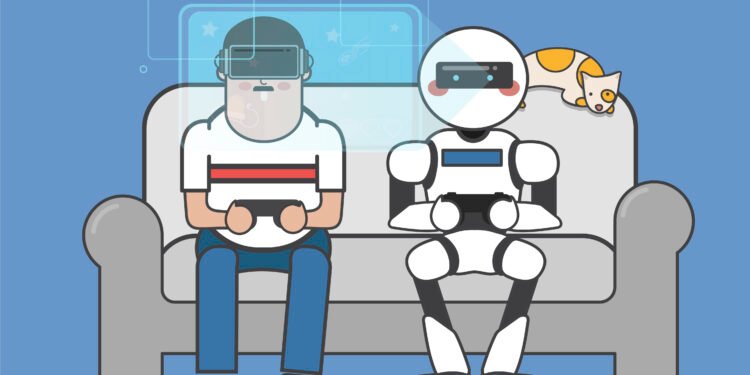For a long time, maximizing the potential of augmented reality (AR) and artificial intelligence (AI) in the workplace has been a major business concern. Companies across industries have successfully implemented various AI and AR systems, particularly for customer care and support. Between 2021 and 2028, the global AR industry is expected to grow at a compound annual growth rate (CAGR) of 43.8%. AR and AI have undoubtedly become contentious issues among marketers.
Before we continue, let’s learn more about augmented reality and artificial intelligence.
Augmented Reality (AR)
The initial AR vision is the critical breakthrough that connects informal communities, geo-based tracking, and the semantic web.
In other words, imagine Augmented Reality as your personal computerized butler. It will become more acquainted with your habits so that it can predict your choices based on your companions, location, and how you search the web. Cyberpunk fiction has become a reality thanks to augmented reality. The social implications are just as compelling as the marketing opportunities.
Wired, Mashable, Fast Company, and ReadWriteWeb have all made strides in the field of augmented reality. Companies like GE, IBM, Walmart, and P&G, on the other hand, are going beyond simply attempting to engage customers with AR.
Artificial Intelligence (AI)
Artificial intelligence’s rapid advancement in the last three years has changed how sponsors interact with their clients. You will eventually gain access to cutting-edge programming and customer data for more targeted, focused, and engaging marketing.
It should come as no surprise that an increasing number of businesses want to increase their marketing expenditures in the next year. Marketing will go through a major transformation in the next years and will be virtually unrecognizable from its current state. There are signs of this future all around us right now. A mind-boggling example is AI-powered voice assistants on your mobile phones doing important functions.
What Should Marketers Know?
Machines Will Analyze User Behavior: This step toward innovation indicates a shift toward artificial intelligence. In this adjustment, machines can observe user behaviour and improve the way we live. Receiving GPS not only saves us time in our activities, but it also allows us to clear our minds and make room for new ideas. It is a “pre-thinking” process that augmented reality mirrors. Meanwhile, Apple is working on incorporating augmented reality into the cameras on its smartphones. They are most likely attempting “smart spectacles.” This comes as no surprise given that the world’s best tech companies are working on the same thing. Facebook is developing one, while Snapchat’s Spectacles are already available to the public.
Customer Support via Virtual Assistant: Web indexes continue to play an important role in content discovery, with Google alone handling 2 trillion searches per year. It can play music based on your mood, manage your schedule, and manage a significant portion of your life. We can expect to see human characteristics in such AI-controlled chatbots once the government provides more information to Facebook. Client collaborators are now expected to perceive people through multiple channels based on their facial expressions and voices. Tempo is one such programme that can remember your preferences. Rhythm aids in the extraction of unique pieces of information and the linking of locations that would otherwise have been captured.
Labeling Taxonomies:Geo-tagging is a great example of labelling taxonomies. It enables you to create material, sound, or video that a physical location can access via AR-enabled cell phones. People who visit that location later will be able to see the material you have left behind. This astute planning strategy, as well as the virtual offers pushed our way when we’re near nearby businesses, will become the norm. Preparation via dating administrations such as Match.com, as well as geo-enabled tweets, will influence social behaviour.
Auto Content Creation: Gartner predicts that by 2020, robo-writers will produce 20% of all business content. While some companies have taken part, there is still much more to be done in terms of AI-generated content. Making tools will create material based on statistics and precise information in a distinct vernacular. This material can include open explanations, white papers, reports, and specific records, and the possibilities are endless. It’s amazing that a robot writer can produce 2,000 firm-specific, data-driven pieces per second. People will eventually notice and value robot-generated items.
Conclusion
Artificial intelligence (AI) and augmented reality (AR) will change the way you communicate with your customers. In the coming years, these new technologies will undoubtedly have an impact on your marketing and business.





